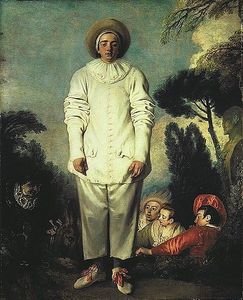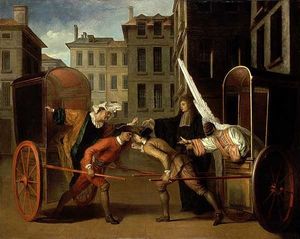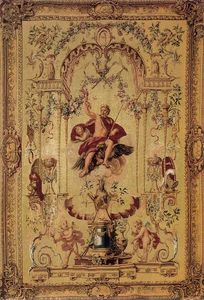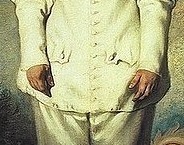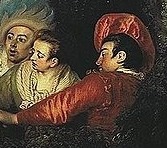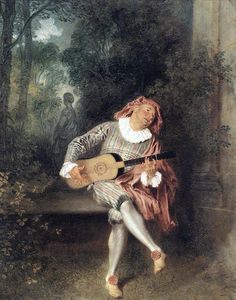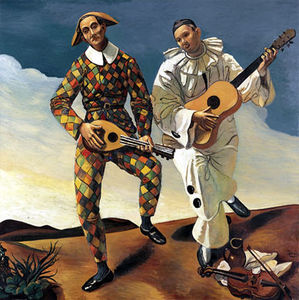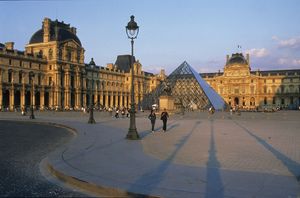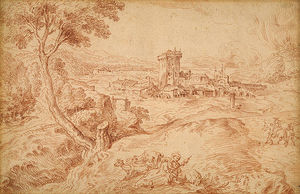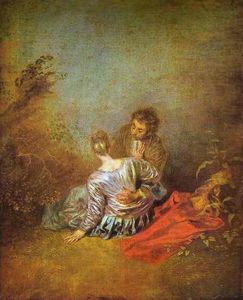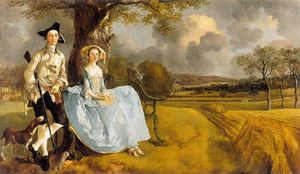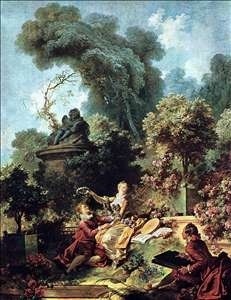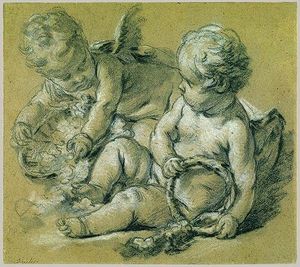Pierrot formerly known as Gilles
- Date of Creation:
- circa 1719
- Height (cm):
- 185.00
- Length (cm):
- 150.00
- Medium:
- Oil
- Support:
- Canvas
- Subject:
- Figure
- Art Movement:
- Rococo
- Created by:
- Current Location:
- Paris, France
- Displayed at:
- Musée du Louvre
- Owner:
- Musée du Louvre
- Pierrot formerly known as Gilles Page's Content
- Story / Theme
- Analysis
- Related Paintings
- Locations Through Time - Notable Sales
- Artist
- Art Period
- Bibliography
Pierrot formerly known as Gilles Story / Theme
The subject of Pierrot (meaning an actor, masquerader, or buffoon) is unclear. It may have been a theatrical sign for a café or it could have been a sign for a fairground show.
Generally the character of Pierrot in the Commedia dell'Arte was staged to be the fool. Watteau's sad clown has reason to be sad as he may be destined for a broken heart. Traditionally, the Pierrot's love interest, Columbine, leaves him for Harlequin. Despite his fate, the character of Pierrot is trusting and proves to be naïve, moonstruck and distant to reality.
It is unknown whether Watteau himself was the inspiration for this piece, as some critics believe this to be a self-portrait, or whether the character of Pierrot was a friend of his, an actor, or an entirely fictional character all together.
No matter who inspired the sad clown, this piece, like Watteau's other paintings, revolves around the theater. Such inspiration can go as far back to Watteau's time spent working with set designer Claude Gillot. Gillot introduced Watteau to the theater, specifically the Italian Commedia dell'Arte.
In this piece Pierrot is the main attraction on the stage but is not the only character from the Commedia dell'Arte feature in his painting; the doctor on his donkey, the lovers Leander and Isabella, and the captain also make an appearance.
Where style is concerned, Watteau's inspiration is borrowed from interior designer Claude Audran III whom he worked with after Gillot. His airy style can be attributed to what he learned with Audran. Watteau transformed the style that had begun to dominate interior design into his paintings.
Pierrot formerly known as Gilles Analysis
It is important for the viewer to understand the meaning behind a painting and how an artist approached his work. Watteau paid special attention to the composition, coloring, lighting and perspective of each piece.
Composition:
Pierrot draws the viewer's attention. His ballooning midsection is attention grabbing enough and his presence is at an elevated center stage. Still, he seems to go unnoticed by his fellow characters.
Somehow, despite his external loudness, his inner quietness causes him to blend in. He is all alone in his world on stage. The viewer wonders whether to feel sympathy or overlook him and share the apathetic sentiments towards this lonely character.
Tone:
It seems that the artist took the generalized notion of the Pierrot into account, as his portrayal of the subject shows him looking down with arms to his side. Though his expression is questionable, his gesture seems to denote that of confusion.
Perhaps he wonders how it happened that his love left him. It is also possible that he is still love struck and the heart break has yet to happen.
Use of light:
While his face remains in the shadow for the most part, the right side more heavily than the left, it is interesting that Watteau chose to highlight the belly of Pierrot; he draws particular attention to what is clearly the most unflattering part of the character.
Maybe Pierrot's face doesn't matter; not to himself, the people around him, or the viewer. Maybe not even to the artist. It is indeed a sad face, a theme contrasting Watteau's happier works of people enjoying love and flirting. Pierrot is not part of any festive group. His silly wardrobe stands in strong opposition to his counterparts. He does not fit in.
Perspective:
Pierrot is seen head-on, enveloped by the characters below him and the trees surrounding him. The negative space in the upper left-hand corner draws attraction to his confused expression.
Color palette:
Watteau portrays all of this through light brushstrokes and equally delicate colors. He paints with a mostly neutral palette except for the laces of Pierrot's shoes and the bright red costume below him.
Pierrot formerly known as Gilles Related Paintings
Pierrot formerly known as Gilles Locations Through Time - Notable Sales
Pierrot formerly known as Gilles Artist
More modern art critiques, such as Jed Perl (author of Antoine's Alphabet) are spreading a renewed interest in Watteau. His appreciation for his "favorite artist" is contagious, as it inspires fellow art admirers.
Pierrot has been featured in recent articles of prestigious newspapers, including the NY Times in 2008.
Completed just two years before his death, Pierrot did not receive as much recognition as it deserved in its day.
Jean-Antoine Watteau is attributed to extending the bounds of the 18th century French-born Rococo at period beyond architecture, furniture and sculpture and into painting.
In his short career he was attributed to developing a unique style and revolutionizing the art world through his individuality. This was seen not only in the themes of his theatrically-influenced work but also in his ornate and airy style.
Watteau's influence on the art world, encompassing costume, film, poetry, music was more extensive than that of almost any other eighteenth century artist. He had many followers during his career but also a lot of critics. Despite his reputation diminishing with the fall of Rococo, it was restored after the French Revolution.
His time spent as an apprentice to set maker, Claude Gillot, contributed to his love of theater. Studying under interior designer Claude Audran III aided in development of beauty and enchantment of his design.
Pierrot formerly known as Gilles Art Period
Watteau was a key player in the 18th century Rococo art movement. The word Rococo is a combination of the French rocaille, or shell, due to the heavy usage of shell-like curves, and the Italian barocco, or Baroque style for its decorative nature.
Its style emergence was first displayed in the decorative arts and interior design before Watteau adapted it toward painting aesthetics. Louis XV's succession brought a change in the court artists and general artistic fashion.
By the end of the old king's reign, rich Baroque designs were giving way to lighter elements with more curves and natural patterns. These elements are obvious in the architectural designs of Nicolas Pineau.
During the Régence, court life moved away from Versailles and this artistic change became well established, first in the royal palace and then throughout French high society. The delicacy and playfulness of Rococo designs is often seen as perfectly in tune with the excesses of Louis XV's regime.
Rococo painting, as well as most French art of the 18th century was light, airy, frilly and bejeweled, which is fitting as it was intended for the powerful aristocracy and wealthy upper-middle class. Examples of Rococo art are displayed on the right.
Watteau's artistic content could be summarized by two major influences: his love for the theater and his fascination of the Rococo styling and design.
Spending his early years in Paris in the workshop of set designer Claude Gillot, Watteau gained his love for the theater, specifically for the Italian Commedia dell'Arte and its innumerable characters. Shortly after, he worked for interior designer Claude Audran III and picked up Rococo design influences.
Watteau's attraction to Rococo's curving lines and decorative nature became central to his later work. As his career progressed the artist combined his love for the theater and his fascination of the Rococo styling and design and developed a truly unique style of painting with ornate elegance that gained him critical attention.
Pierrot formerly known as Gilles Bibliography
To find out more about Watteau and his works please choose from the following recommended sources.
• Lauterbach, Iris. Antoine Watteau: 1684-1721. PLACE, 2008
• Mollett, John William. Watteau. Kessinger Publishing, LLC, 2007
• Perl, Jed. Antoine's Alphabet: Watteau and His World. Random House, 2008
• Posner, Donald. Antoine Watteau. Cornell University Press, 1984
• Rogers, Robert Emmons. Behind A Watteau Picture: A Fantasy in Verse in One Act. Kessinger Publishing, LLC, 2007
• Sheriff, Mary D. Antoine Watteau: Perspectives on the Artist and the Culture of His Time. University of Delaware Press, 2006
• Stranahan, C. H. A History of French Painting From the Earliest To Its Latest Practice. Charles Scribner's Sons, 1918
• Zeri, Federico. Watteau: The Embarkation for Cythera. NDE Publishing, 2000

